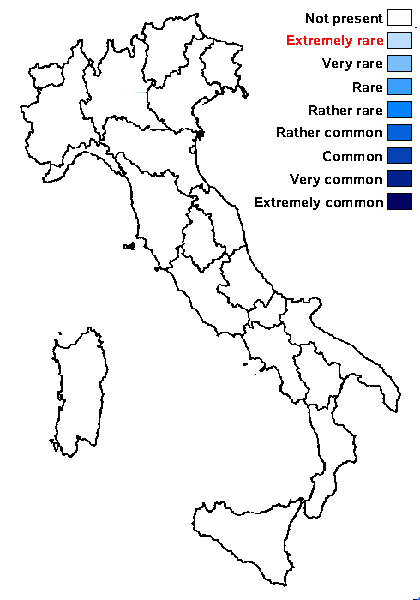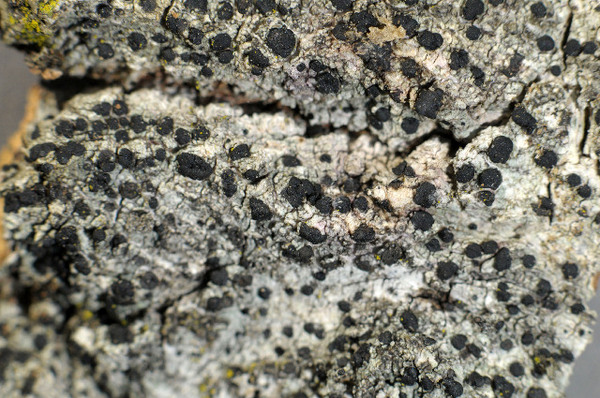Lecidella tumidula (A. Massal.) Knoph & Leuckert
Bibl. Lichenol., 68: 131, 1997. Basionym: Lecidea tumidula A. Massal. - Ric. Auton. Lich. Crost.: 71, fig. 137, 1852
Synonyms:
Distribution: N - Ven (Massalongo 1852).
Description: Thallus crustose, episubstratic, more or less continuous to rimose-granulose, 0.6-1 mm thick, white to greenish yellow to whitish grey, sometimes delimited by a pale to dark prothallus. Apothecia lecideine, black, semi-immersed to sessile, slightly to strongly constricted at base, 0.8-1.2 mm across, with a flat to finally convex, epruinose disc, and a c. 0.075 mm thick, finally often excluded proper margin. Proper exciple bluish to greenish black in outer part, yellowish to reddish brown within, without crystals; epithecium green, blackish green to bluish green; hymenium colourless, 50-90 µm high, not inspersed with oil droplets; paraphyses easily made free in K, mostly simple, rarely sparingly branched and anastomosing, the apical cells not to slightly thickened; hypothecium reddish brown to rarely yellowish brown. Asci 8-spored, clavate, with an intensely K/I+ blue tholus penetrated by a faintly amyloid, broadly cylindrical axial mass, and a poorly developed ocular chamber, the wall K/I-, surrounded by a K/I+ blue outer layer, approaching the Lecanora-type. Ascospores 1-celled, hyaline, broadly ellipsoid to ovoid, 9-14 x 5.5-7.5 µm, thick-walled, not halonate. Photobiont chlorococcoid. Spot tests: thallus K-, C-, KC-, P-, UV-. Chemistry: diploicin and lichexanthone.Note: a critical, long-forgotten taxon of the difficult L. elaeochroma-complex, described from Veneto, on Juglans, and recently found also in China and Western North America. It differs from other related species by the presence of diploicin. The whole complex need a thorough revision in Italy.
Growth form: Crustose
Substrata: bark
Photobiont: green algae other than Trentepohlia
Reproductive strategy: mainly sexual
Poorly known taxon in need of further study
Commonnes-rarity: (info)
Alpine belt: absent
Subalpine belt: absent
Oromediterranean belt: absent
Montane belt: absent
Submediterranean belt: extremely rare
Padanian area: absent
Humid submediterranean belt: absent
Humid mediterranean belt: absent
Dry mediterranean belt: absent

Predictive model
Growth form: Crustose
Substrata: bark
Photobiont: green algae other than Trentepohlia
Reproductive strategy: mainly sexual
Poorly known taxon in need of further study
Commonnes-rarity: (info)
Alpine belt: absent
Subalpine belt: absent
Oromediterranean belt: absent
Montane belt: absent
Submediterranean belt: extremely rare
Padanian area: absent
Humid submediterranean belt: absent
Humid mediterranean belt: absent
Dry mediterranean belt: absent

Predictive model
 Index Fungorum
Index Fungorum
 GBIF
GBIF


